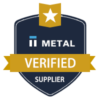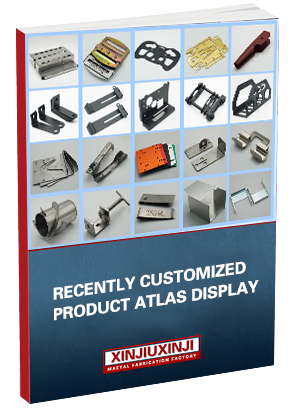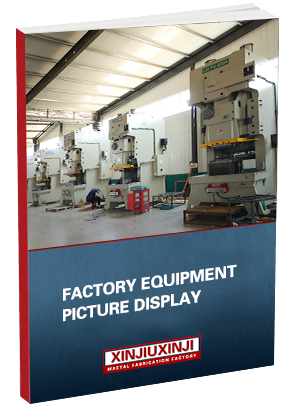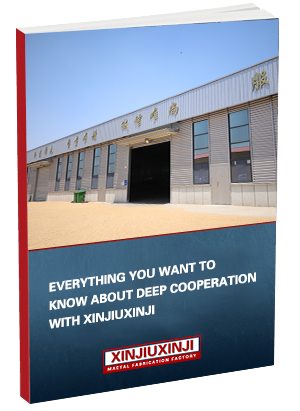Glossary Of Metal Stamping Terms
Xinjiuxinji is a specialized metal processing factory that excels in a comprehensive range of techniques, including laser cutting, bending, metal stamping, welding, deep drawing, and surface treatment. Our expertise in these advanced processes underscores our commitment to delivering high-quality, customized solutions. With extensive experience in global metal processing projects, we are well-equipped to meet diverse client needs, ensuring precision and reliability in every endeavor. Learn about our Glossary Of Metal Stamping Terms in the metal fabrication.

Glossary of Metal Stamping Terms:Professional metal fabrication customization
Here’s the content converted into a table format:
| Term | Description |
|---|---|
| Laser Cutting | A method using focused laser beams to precisely cut materials. |
| Bending | The process of deforming metal into specific angles or curves. |
| Stamping | Shaping metal sheets using dies and presses for desired forms. |
| Welding | Joining metal parts by melting them together to create a strong bond. |
| Deep Drawing | Forming process creating deep, hollow shapes from sheet metal. |
| Surface Treatment | Processes that enhance a metal’s surface properties, like corrosion resistance. |
| Machining | Removing material from a workpiece to achieve specific dimensions. |
| Milling | A machining process using rotating cutters to shape a material. |
| Turning | Rotating a workpiece against a cutting tool to create cylindrical shapes. |
| Grinding | An abrasive process that smooths a material or achieves precise dimensions. |
| Electroplating | Coating a metal with another metal using an electric current for improved properties. |
| Anodizing | An electrochemical process increasing corrosion resistance, especially on aluminum. |
| Forging | Shaping metal using compressive forces, enhancing its strength and durability. |
| Casting | Pouring molten metal into a mold to form a specific shape as it cools. |
| Heat Treatment | Altering a material’s physical properties through controlled heating and cooling. |
| Brazing | Joining metals using a filler that melts above 450°C, without melting base metals. |
| Soldering | Similar to brazing but uses a lower melting point filler material for joining metals. |
| Sheet Metal | Flat pieces of metal used extensively in manufacturing processes. |
| Alloy | A mixture of metals to enhance properties like strength or resistance. |
| Tensile Strength | The maximum stress a material can withstand while being stretched. |
| Ductility | A material’s ability to deform under tensile stress without breaking. |
| Fatigue | Weakening of a material due to repeated stress cycles, leading to failure. |
| Elongation | The extent to which a material can be stretched before breaking. |
| Oxidation | A chemical reaction where metals react with oxygen, leading to rust. |
| Flux | A cleaning agent used in welding and soldering to promote fusion. |
| Machinability | The ease with which a material can be machined to specifications. |
| Jig | A device that holds a workpiece in place during machining operations. |
| Fixture | A tool that secures and supports a workpiece during manufacturing. |
| Tolerance | The allowable variation in a physical dimension of a part. |
| CAD (Computer-Aided Design) | Software for creating precise technical drawings and designs. |
| CAM (Computer-Aided Manufacturing) | Software that automates manufacturing processes using machinery. |
| Prototype | An initial model of a product used for testing and design refinement. |
| Quality Control | Procedures ensuring products meet specified quality standards. |
| Surface Finish | The texture and smoothness of a material’s surface affecting performance. |
| Weld Penetration | The depth a weld metal penetrates the base material during welding. |
| Gage | A measurement tool for determining the thickness of sheet metal. |
| Burr | A rough edge left on a workpiece after cutting or machining. |
| Corrosion Resistance | A material’s ability to withstand degradation from chemical reactions. |
| Interpass Temperature | The temperature of base material between welding passes. |
| Bead | A deposit of weld material formed during the welding process. |
| Mill Finish | The initial finish of a metal product as it comes from the mill. |
| Hot Working | Metal forming processes performed at elevated temperatures to reduce strength. |
| Cold Working | Forming processes done at room temperature to increase material strength. |
| Draw Die | A tool used in processes like deep drawing to shape metal. |
| Tooling | Creating tools and equipment for manufacturing operations. |
| Yield Strength | The stress at which a material begins to deform permanently. |
| Seam Welding | Joining two metal pieces along a seam using electric current. |
| Continuous Casting | A method of solidifying molten metal into a continuous shape. |
| Dye Penetrant Testing | A non-destructive method for detecting surface defects. |
| X-ray Inspection | Using X-rays to identify internal flaws in a material. |
| Rolling | A metalworking process where metal is passed through rollers to reduce thickness. |
| Vibration Testing | Evaluating material performance under vibrational forces. |
| Blanking | Cutting flat shapes from sheet metal for further processing. |
| Cutting Fluid | A liquid used to cool and lubricate cutting tools during machining. |
| Tapping | Creating internal threads in a hole using a cutting tool. |
| Chamfering | Creating a beveled edge on a workpiece to prevent chipping. |
| Coating | Applying a layer of material to enhance protection or aesthetics. |
| Riveting | Joining two or more pieces of metal using metal pins called rivets. |
| Profiling | Shaping a material to a specific contour or profile. |
| Heat Exchanger | A device that transfers heat between two or more fluids, often made from metals. |
| Cladding | Bonding a thin layer of one metal to the surface of another for protection or aesthetics. |
| Honing | A finishing process using abrasive stones to improve surface finish and dimensions. |
| Press Brake | A machine used for bending sheet metal accurately. |
| Induction Heating | A method of heating metals through electromagnetic induction for processes like welding. |
| Pultrusion | A continuous process for manufacturing composite materials with a constant cross-section. |
| Sintering | A process of compacting and forming a solid mass of material using heat without melting. |
| Lamination | Bonding multiple layers of material together to improve strength or reduce weight. |
| Shearing | Cutting metal sheets into desired shapes without forming chips. |
| Plasma Cutting | A process that uses a plasma torch to cut through electrically conductive materials. |
| Laser Engraving | Using lasers to etch designs or markings onto a material’s surface. |
| Thermal Spray Coating | Applying a coating by heating a material and spraying it onto a surface. |
| Computer Numerical Control (CNC) | Automated control of machining tools via a computer. |
| Swaging | A process that shapes metal by reducing its diameter through dies. |
| Sheet Metal Forming | Processes that shape sheet metal into desired forms. |
| Bending Brake | A tool used to bend sheet metal at precise angles. |
| Vacuum Forming | A process of shaping plastic sheets using heat and vacuum pressure. |
| Sawing | Cutting materials using a saw blade for various applications. |
| Tensile Testing | Measuring a material’s strength and ductility by stretching a sample until it breaks. |
| Pressure Testing | A method of checking for leaks or weaknesses in a vessel under pressure. |
| Reaming | Enlarging or finishing a hole to precise dimensions. |
| Notching | Making a cut or groove in a material to create a specific shape or joint. |
| Electrode | A conductor through which electric current enters or leaves a medium during welding. |
| Fabrication | The process of constructing products from raw materials through cutting, bending, and assembling. |
| V-Block | A tool used for holding round workpieces during machining. |






 +86 18892239158
+86 18892239158



